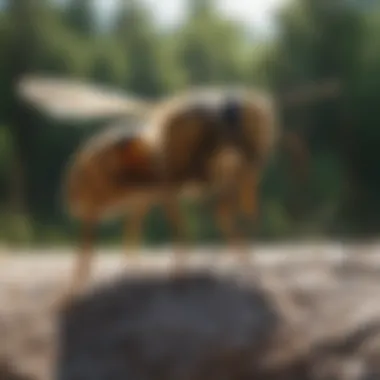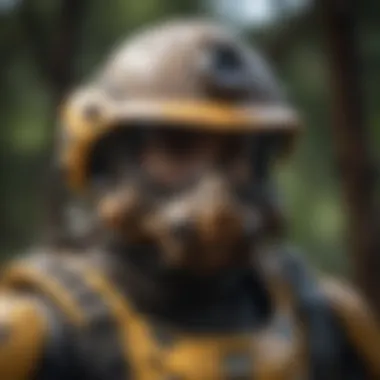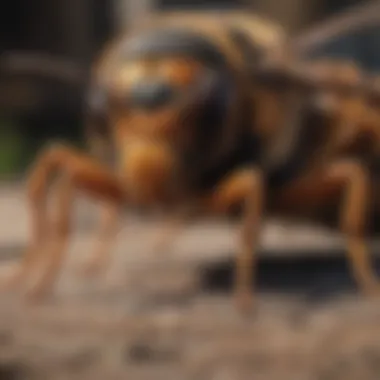Expert Guide on Safely Removing Hornets' Nests - Effective Techniques Revealed


Animal Species Profile
Hornets, the notorious members of the Vespidae family, are known for their striking black and yellow markings that often evoke fear and caution in humans. These aerial insects possess a slender body, with a narrow waist and transparent wings, adding to their menacing appearance. Hornets prefer to construct their nests in sheltered outdoor locations, such as trees, walls, or eaves, where they can establish thriving colonies.
Their aggressive behavior is a hallmark trait, especially when their nest is threatened, leading to painful stings that can trigger severe reactions in individuals. Hornets display a complex social structure within their colonies, with a queen responsible for reproduction, worker hornets handling nest-building and foraging, and male hornets focused on mating activities. Understanding the physical attributes and social dynamics of hornets is crucial in safely and effectively removing their nests.
Efficient Removal Techniques
When facing the daunting task of eliminating a hornets' nest, prioritizing safety is paramount. Before commencing removal procedures, ensure to wear thick protective clothing, including long sleeves, pants, gloves, and a veil to guard against potential stings. Access the nest during the night when hornets are less active and more docile, reducing the risk of provoking aggressive behavior.
Utilize a commercially available insecticidal dust specifically designed for wasps and hornets by applying it directly into the nest entrance. This ensures the targeted elimination of hornets within, minimizing the chances of a defensive swarm. Alternatively, deploying a pressurized insecticide spray can offer rapid results, incapacitating the hornets on contact. It is advisable to retreat from the vicinity promptly after application to evade contact with any surviving hornets.
Following the extinction of hornet activity, cautiously remove the nest from its location using a long stick or a similar tool to maintain a safe distance. Subsequent disposal of the nest is crucial to prevent any remnants from attracting a new colony in the future. Employing these meticulous removal techniques guarantees a successful extraction of hornets' nests without risking unnecessary harm or disturbance.
Understanding Hornets' Nests
Hornets' nests are not just simple structures; they are intricate dwellings that demand attention and understanding. In this comprehensive guide on the efficient removal of hornets' nests, we delve deep into the significance of comprehending these nests. By grasping the complexities of hornets' nests, individuals can better ensure their safety and that of their surroundings. Understanding Hornets' Nests is pivotal for anyone looking to eliminate these potential threats effectively. Without a clear understanding of hornets' nests, removal attempts may prove futile or even hazardous. Therefore, this section serves as the foundation for a successful nest removal process, emphasizing the need for knowledge before action.
Introduction to Hornets' Nests
When embarking on the journey of hornets' nest removal, it is essential to start with a solid foundation. The overview of hornets and their nests provides vital insights into the nature of these buzzing inhabitants. Hornets construct their nests using a mixture of saliva and wood fibers, crafting sturdy colonies that house their young. This overview offers a glimpse into the architectural wonder that is a hornets' nest, shedding light on the intricacies of their construction and layout. Understanding the details of hornets' nests allows individuals to approach removal tasks with caution and precision.
Overview of hornets and their nests
The overview of hornets and their nests details the unique characteristics that define these structures. From their paper-like exterior to the chambers within, hornets' nests are marvels of engineering. This insight enables individuals to appreciate the complexity of these dwellings and the challenges they pose during removal. By exploring the intricacies of hornets' nests, readers gain a deeper appreciation for the delicate balance that exists within these colonies.
Why removal is necessary
The necessity of hornets' nest removal stems from the potential dangers these structures pose. Hornets can exhibit aggressive behavior when they feel threatened, putting individuals at risk of painful stings. Removing hornets' nests is crucial in safeguarding homes, gardens, and outdoor spaces from these threats. Failure to address nest infestations promptly can lead to escalating problems, making removal a vital step in pest control management.
Identifying Hornets' Nests


Recognizing the distinctive features of hornets' nests is a crucial skill for effective removal. By understanding the characteristics and common nesting areas of these structures, individuals can locate nests and plan removal strategies accordingly.
Characteristics of hornets' nests
Hornets' nests boast characteristics that set them apart from other insect dwellings. Their spherical shape, intricate layers, and distinct hexagonal cells all contribute to their unique appearance. These features play a key role in nest identification, allowing individuals to differentiate between hornets' nests and those of other stinging insects. Understanding the specific characteristics of hornets' nests is essential for successful nest removal efforts.
Common nesting areas
Hornets typically select sheltered locations for nest construction, preferring areas that offer protection from the elements. Common nesting spots include trees, shrubs, eaves, and attics, providing hornets with the seclusion they seek. By pinpointing these typical nesting areas, individuals can conduct thorough inspections of their properties to detect potential nest sites. Awareness of common nesting areas enhances the chances of early nest identification, facilitating timely removal actions.
Safety Precautions Before Removal
Safety precautions before hornets' nest removal play a crucial role in ensuring a smooth and incident-free process. Before embarking on this task, it is essential to prioritize safety to prevent any potential harm or accidents. Hornets are known for their defensive nature, especially when their nests are disturbed, making it imperative to follow proper safety procedures. Understanding the significance of safety precautions before removal can significantly reduce the risk of stings and injuries, creating a secure environment for both the remover and nearby individuals. Invest time and effort in preparing adequately for the removal process, beginning with a comprehensive assessment of the nest location and potential hazards. Being proactive in implementing safety measures minimizes the chances of emergencies and promotes a successful removal operation.
Protective Gear
Protective gear is a non-negotiable aspect when dealing with hornets' nests. Proper attire and equipment are essential in shielding oneself from potential stings and ensuring a safe removal process. Understanding the components of protective gear and their significance is vital for a successful operation.
Recommended attire for safety
When it comes to recommended attire for safety, prioritizing full-coverage clothing is paramount. Opt for thick, long-sleeved shirts, pants, and gloves to minimize exposed skin, reducing the risk of stings. Additionally, choose light-colored clothing, as this makes it easier to spot any incoming hornets. A wide-brimmed hat and closed-toe shoes are also recommended to protect the head and feet. Lastly, ensure that clothing fits snugly to prevent any insects from crawling inside.
Importance of protective equipment
The importance of protective equipment in hornets' nest removal cannot be overstated. Proper gear serves as a barrier between the remover and potential stings, offering a layer of protection against aggressive hornets. Investing in high-quality protective gear enhances safety levels and boosts confidence during the removal process. By using suitable equipment, individuals can focus on the task at hand without the constant worry of being stung. Additionally, protective gear instills a sense of preparedness and control, essential elements in managing any unexpected situations. Emphasizing the significance of protective equipment reinforces the commitment to safety and the well-being of all involved in the removal process.
Choosing the Right Time for Removal
Choosing the right time for removal plays a pivotal role in ensuring the effective eradication of hornets' nests. Timing is crucial when dealing with these intricate structures. Understanding the optimal conditions for nest removal can significantly impact the safety and success of the operation. The factors that influence the timing of removal range from weather conditions to the hornets' activity levels. By strategically selecting the ideal moment, individuals can enhance the efficiency of the eradication process.
Optimal Timing


Factors to consider before removal
One of the key considerations before hornets' nest removal is assessing the weather conditions. Best undertaken during cooler temperatures, removal should avoid peak times when hornets are most active. Additionally, evaluating the nest size and accessibility are crucial factors. Larger nests may require more time and specialized equipment for safe removal. Understanding the behavior of hornets and their nesting patterns enables individuals to plan the removal effectively. By considering these factors, one can mitigate risks and ensure a smooth removal process.
Best time of day for nest removal
Selecting the best time of day for nest removal is imperative for a successful operation. Typically, early morning or late evening are preferred times as hornets are less active during these periods. Conducting removal during daylight ensures better visibility, aiding in precision and reducing the likelihood of accidental stings. However, personal safety should remain a top priority, and proper protective gear must always be worn. Choosing the appropriate time of day aligns with the natural rhythms of hornets, enhancing the likelihood of a smooth and successful nest removal process.
Methods for Hornets' Nest Removal
In this section of the article, we delve into the crucial topic of Methods for Hornets' Nest Removal, a pivotal aspect when dealing with these buzzing insects. Understanding the appropriate techniques for nest removal is paramount for ensuring safety and efficiency in hornet control. By exploring the various methods available, readers will gain valuable insights on how to approach this challenging task with confidence and effectiveness. Whether opting for natural remedies, commercial products, or professional assistance, each approach comes with its own set of considerations and benefits to be evaluated meticulously.
Natural Remedies
Essential oils
Essential oils play a significant role in hornet nest removal due to their natural properties that can deter these stinging insects effectively. The concentrated nature of essential oils, such as eucalyptus or peppermint, acts as a potent repellent against hornets, making them a popular choice for eco-conscious individuals. The key characteristic of essential oils lies in their ability to disrupt the hornets' communication and navigation, leading to nest abandonment. While their non-toxic nature is advantageous for the environment, their potent aroma could be a drawback if individuals are sensitive to strong scents. By understanding the application and dosage of essential oils, readers can harness their power to tackle hornet infestations successfully.
Vinegar solutions
Vinegar solutions offer a cost-effective and environmentally friendly method for hornet nest removal. The acidic nature of vinegar creates an inhospitable environment for hornets, encouraging them to relocate their nest. A key characteristic of vinegar solutions is their versatility in application, as they can be easily sprayed on the nest or surrounding areas. This simplicity makes them a popular choice for DIY enthusiasts seeking a natural and accessible solution. However, the strong smell of vinegar could be a disadvantage for those sensitive to odors. By weighing the advantages of vinegar solutions against any potential drawbacks, individuals can decide if this natural remedy aligns with their hornet control goals.
Commercial Products
Insecticidal sprays
Insecticidal sprays constitute a powerful tool in hornet nest removal, offering a quick and direct method for eliminating these pests. The key characteristic of insecticidal sprays lies in their ability to deliver a targeted and rapid response to hornet nests, ensuring efficient eradication. Their wide availability and ease of use make them a popular choice for individuals looking for immediate results. However, the chemical nature of insecticidal sprays may pose risks to beneficial insects and the environment if used indiscriminately. By following the instructions carefully and exercising caution, individuals can harness the potency of insecticidal sprays while minimizing any potential harm.
Dust formulations
Dust formulations provide a long-lasting and residual solution for hornet nest removal, penetrating the nest's crevices to eliminate the entire population. The key characteristic of dust formulations is their ability to reach hidden or hard-to-access areas within the nest, ensuring thorough eradication of hornets. This makes them a valuable choice for tackling infestations in challenging locations. However, the fine particles of dust formulations may pose respiratory risks if not handled with care. By understanding proper application techniques and safety measures, individuals can leverage the effectiveness of dust formulations in combating hornet nests while prioritizing personal well-being.


Professional Assistance
Hiring pest control services
Engaging professional pest control services offers a comprehensive and expert-led approach to hornet nest removal, ensuring the effective and safe eradication of these insects. The key characteristic of hiring pest control services lies in the expertise and specialized equipment they bring to the task, guaranteeing thorough elimination of hornet nests. This professional intervention is a beneficial choice for individuals facing extensive or recurrent infestations, providing peace of mind and long-term results. However, the cost associated with professional services may be a consideration for some. By weighing the advantages of professional expertise against the investment required, individuals can make an informed decision on whether to enlist professional assistance in handling hornet infestations.
When to seek professional help
Knowing when to seek professional help in hornet nest removal is crucial for ensuring timely and effective intervention. The key characteristic of recognizing when professional assistance is necessary lies in assessing the scale and complexity of the infestation. Professional help becomes a beneficial choice when dealing with large nests, challenging locations, or recurring issues that require specialized knowledge and equipment. By acknowledging the limitations of DIY methods and prioritizing safety, individuals can make a sound judgment on when to involve professionals in managing hornet infestations. Understanding the advantages of professional intervention and its positive impact on long-term hornet control can guide individuals in making informed decisions for a pest-free environment.
Post-Removal Precautions
In the realm of hornets' nest removal, the phase that follows the successful elimination of the nest is just as critical. Post-removal precautions are essential to ensure a seamless transition from the removal process to the aftermath. As we delve into this significant aspect within the broader context of this informative guide, it is vital to highlight the pivotal role that post-removal precautions play in maintaining safety and preventing potential risks. By meticulously focusing on post-removal measures, individuals can mitigate the likelihood of accidents, re-infestations, and other unwanted consequences, thereby safeguarding both themselves and their environments.
Cleaning and Preventive Measures
Removing debris
When it comes to the meticulous task of removing debris post-hornets' nest eradication, meticulousness is key. Debris removal is not merely about tidying up; it is about eliminating any remnants that could potentially attract new inhabitants. The meticulous clearance of debris serves as a crucial step towards ensuring that the area remains unattractive to future unwanted guests. A fundamental characteristic of debris removal is its ability to create a clean slate, eradicating any traces of the previous nest and deterring hornets from rebuilding in the same spot. The sensibility of choosing debris removal lies in its proactive nature, addressing the root cause of potential re-infestations by erasing any remnants that could signal a welcoming environment for hornets.
Preventing future infestations
Following the removal of a hornets' nest, taking proactive measures to prevent future infestations is paramount. The core characteristic of this preventive action lies in its foresight and strategic approach to long-term nest prevention. By implementing preventive measures, such as sealing entry points, installing deterrents, and maintaining regular inspections, individuals can significantly reduce the risk of recurrent hornets' nest formations. The uniqueness of preventing future infestations rests in its ability to break the cycle of nesting recurrence, offering a sustainable solution to minimize future conflicts with these buzzing insects. While the advantages of this approach are evident in long-term nest prevention, it is essential to acknowledge potential limitations, such as the need for consistent upkeep and adaptability to changing environmental factors to ensure continued effectiveness in deterring hornets from nesting anew.
Conclusion
In wrapping up this extensive guide on the efficient removal of hornets' nests, it is crucial to emphasize the significance of thorough nest removal practices. Ensuring the safety of individuals and the environment is paramount when dealing with potentially hazardous situations like hornet infestations. By following the detailed steps outlined in this article, readers can confidently address hornet nests while minimizing risks and maximizing efficiency. This section serves as a comprehensive resource that consolidates key insights and practical recommendations for successfully managing hornet nests.
Summary of Key Points
Safety first
When considering the aspect of safety first in hornets' nest removal, the primary focus is on safeguarding oneself and others from potential harm. Safety protocols, such as wearing appropriate protective gear and choosing the right removal time, are integral to the overall goal of effective nest elimination. The emphasis on safety underscores the importance of meticulous planning and execution to prevent accidents or stings during the removal process. Adhering to safety guidelines ensures a secure environment for both humans and wildlife in the vicinity.
Effective removal techniques
Addressing effective removal techniques is fundamental to achieving successful hornet nest eradication. By employing natural remedies, commercial products, or seeking professional assistance, individuals can tailor their approach based on the nest size and location. Each method comes with its distinct advantages, whether through environmentally-friendly solutions like essential oils or the swift action provided by insecticidal sprays. Understanding the nuances of each technique enables readers to make informed decisions that align with their specific circumstances, maximizing the effectiveness of nest removal efforts.







